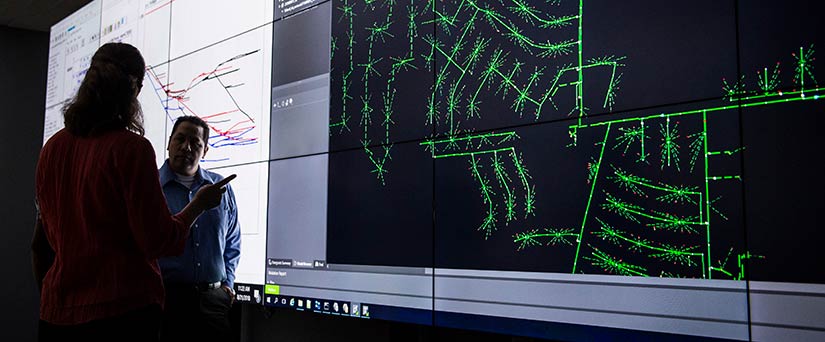Medium-Voltage Power Electronics for Utility Use
NLR's medium-voltage power electronics researchers design wide-bandgap converters, develop robust control algorithms, and analyze interactions and impacts between converters and utility distribution systems.

The growing need for resiliency in power systems and the large-scale integration of renewable energy have boosted demand for new technologies. Medium-voltage power electronics can play a pivotal role in improving the reliability and security of our nation's electric grid.
These activities are focused on enabling high penetrations of renewable energy resources on the U.S. electricity grid while aiding autonomous operation capability. NLR also supports standards development through analysis of new applications of medium-voltage power electronics in direct grid-connected operations.
Capabilities
- Modeling of power converters
- Design and development of wide-bandgap power converters
- Design and development of converter controls and firmware
- High-bandwidth controller-hardware-in-the-loop validations
- High-bandwidth controller- and power-hardware-in-the-loop testbeds for dynamic studies
- Conformance evaluation to IEEE standards
- Dynamic and steady-state grid impact analysis for medium-voltage power electronics converters in power systems
Projects
The goal of the Grid Application Development, Testbed, and Analysis for Medium-Voltage Silicon Carbide project is to develop a technical pathway for the adoption and use of silicon carbide wide-bandgap devices for distribution-level grid applications.
The potential range of directly connected medium-voltage power electronic converters includes:
- Medium-voltage to low-voltage conversion (i.e., a solid-state transformer)
- Medium-voltage to DC conversion to integrate inherently DC systems such as PV, battery energy storage systems, and electric vehicles
- Medium-voltage to medium-voltage back-to-back conversion (the focus of this project), which connects portions of grids together and allows full asynchronous power flow control between intertied distribution systems.
Silicon carbide-based power electronics offer the ability to interconnect to the medium-voltage grid (e.g., 15-kV class) without the use of a line-frequency transformer. Focusing on the development of such systems, NLR researchers are:
- Performing analysis to determine the value of direct-grid connection and how such systems will benefit future grid architectures and operations
- Developing a silicon carbide-based medium-voltage back-to-back converter with the required grid interconnection functionality to demonstrate the feasibility of direct medium-voltage interconnection
- Developing a high-bandwidth, medium-voltage testing capability at NLR's Energy Systems Integration Facility, a Department of Energy user facility open to U.S. industry for evaluating the performance of future medium-voltage power electronic devices.
The project team comprises experts from NLR, Florida State University, and the Ohio State University.
This project aims to design, develop, and demonstrate foundational technologies for multiport power electronics energy hubs that can serve as intelligent devices to coordinate and control several sources and loads.
Power electronic systems on the grid are becoming more common because of the increased integration of distributed energy resources. The power electronic interfaces associated with distributed energy resources are mostly deployed at the distribution and subdistribution levels. One major challenge for utilities is that these power electronic interfaces need to be controlled and coordinated with wide area distribution management systems to effectively use them as resources and manage loads.
This project develops a power electronic hub that will include standardized interfaces, local decision-making capability for individual grid-tied power electronics, and decentralized control for large distribution feeder sections. The features, benefits, and capabilities enabled by this concept include:
- Automation of energy flow between multiple sources and loads with real-time optimization
- Single transactive node that enables market participation or integration into centralized systems
- Grid reliability and resilience for advanced decentralized grid control architecture
- Grid security
- Interoperable and vendor agnostic.
The project team comprises experts from NLR, Oak Ridge National Laboratory, Pacific Northwest National Laboratory, North Carolina State University, and industry partners.
Publications
Grid Value Investigation of Medium-Voltage Back-to-Back Converters, IEEE Power and Energy Society Innovative Smart Grid Technologies Conference (2021)
Grid Application and Controls Development for Medium-Voltage SiC-Based Grid Interconnects, IEEE Energy Conversion Congress and Exposition (2020)
Contact
Share
Last Updated Dec. 6, 2025
